Magnificant photos of Afghanistan . I deal with Afghanis on a regular basis in my carpet shop and they really are a wonderful race of people with such a rich history.There carpets and kilimsuse a limited colour palette that reflects what dye plants are available within their environment .
Stunning photos of the Ma’dan Marsh Arabs Reed Homes
Image
I was estatic to have found this fab article on a website http://www.messynessychic.com. Although it concentrates primarily on the lifestyle and unique reed homes of the Marsh Arabs a significant part of their culture was in fact the beautiful weavings and ecclectic embroideries made by the young woman for their reed homes and for their marriage dowry.
The evocative images of the homes in this artical were fascinating for me as these often exact images are also those that are then translated isymbolicly nto the actual weavings themselves .
As the actual embroideries by these woman are very graphicand symbolic in style the unique designs that I had always presumed were depictions of mosques I have now realised are in fact depictions of the weavers reed homes !Delighted by my little discovery and a further understanding of these people !

It was Iraq’s ‘Garden of Eden’; unique wetlands in southern Iraq where a people known as the Ma’dan, or ‘Arabs of the marsh’, lived in a Mesopotamian Venice, characterised by beautifully elaborate floating houses made entirely of reeds harvested from the open water.

These little-known architectural wonders are known as a ‘mudhif’; built without nails, wood or glass in under three days, even the islands the houses rest on are made of compacted mud and rushes.

It’s a construction method that has been used by the dwellers of the plains for thousands of years, but in recent decades, this exotic architecture has almost completely disappeared, and at risk of being lost along with it of course, is the ancient knowledge of the unique building technique itself.

Why would such a beautiful waterworld disappear, you ask? As with most of the injustice that marred Iraq during the late 20th century the destruction of this Middle Eastern paradise came at the hands of one defiant dictator, Saddam Hussein. The marshes and their floating reed homes had for some time been considered a refuge for those persecuted by the government of Hussein, and in past centuries they had been a refuge for escaped slaves and serfs.

During the 1991 uprisings in Iraq, Saddam Hussein drained the unique wetlands of southern Iraq as a punishment to the marsh arabs who had backed the uprising and allegedly given refuge to militiamen the government regarded as terrorists.

The Iraqi government aggressively revived a 1970s irrigation project that had initially been abandoned after it began to disrupt the flow of water to the marshes. Very quickly, their food source was eliminated, their villages were attached and burnt down and their lush paradise systematically converted into a desert. What little water remained was reportedly poisoned.

Residents in their thousands were forced from their settlements, abandoning their traditional lifestyle in favour of towns and camps in other areas of Iraq or to Iranian refugee camps. Only 1,600 of of the nearly half million Marsh Arabs recorded in the 1950s were estimated to still be living in the traditional housing in the new millenium.

It was considered a lost culture until a remarkable recovery began to take place in 2003 when local communities began breaching Saddam Husseins’s dikes after the U.S. invasion of Iraq. A four year drought also came to an end that same year and the wetlands have now been restored to cover more than 50% of the 1970s water levels (pictured above). The ecosystem however may take far longer to restore than it took to destroy and many of the Marsh Arabs have moved on and those that return are greeted with no clean drinking water, poor sanitation, and no health care or education facilities.

Only miles away from cities devastated by war, there are few willing to risk their lives to save a marsh and its dwindling eco-friendly community, however, there is hope. Nature Iraq, founded by an Iraqi-American hydraulic engineer who gave up his life in California to help restore the country’s lost garden of eden, is leading efforts with financial support from the United States, Canada, Japan, and Italy.

One of their most recent efforts to rebuild the Ma’dan community saw the organisation re-construct a traditional mudhif, to demonstrate how the alternative, low-cost and sustainable building methods could work once again.

In the spirit of the Ma’dan community, which throughout history has given refuge to those in need, the reed abode acts as a guest house, offering accommodation for long-term stays, as well as a community centre where locals and travellers alike can have meals and share discussions about the future of Iraq’s garden of Eden. You can follow the progress on Facebook with Nature Iraq here.
Who knows? One day you might be gliding through the channels of Iraq’s wetlands lined with beautiful reed houses as flocks of birds fly through the reddish evening sky above.
Images via Flickr, Tracy Shelton and Google images
The Guide Istanbul- a great way to keep up on whats happening in the ‘bul’ !
I love that Istanbul in some areas is moving to a more mainstream understanding of sprituality . Wıth 99%of all Turkish people professing to be Muslim new ideas and concepts of spirituality have taken some time to flourish.
http://www.theguideistanbul.com/news/view/1823/spirituality-in-istanbul-part-3-diana-jaramillo/
Care & Cleaning of your Handmade Rug
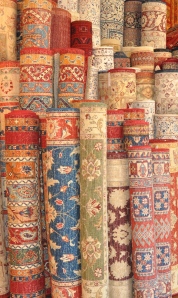
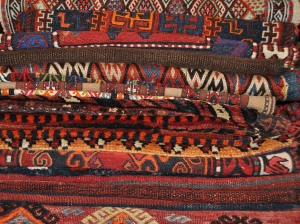
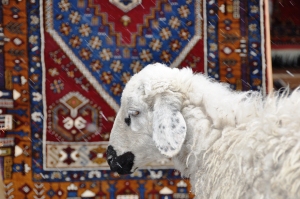
Care and Cleaning of your Handmade Rug.
Customers and friends ask me all the time how they should look after and care for their rugs . In fact its easy and rugs do love to be walked on and enjoyed, so once you know a few pointers for keeping your carpets and kilims looking great you can enjoy them even more .
A dirty or stained carpet should be washed with soft natural soap or baby shampoo , rinsed with cold water only and left to dry in the shade .
I find the best way to do this is to vacuum your carpet first and then head for the nearest flat surface like a driveway. Thoroughly wet the carpet ,lather with shampoo with a very soft broom and clean thoroughly on both sides with the water running . Keep the water running over the carpet until it runs clear and then ensure the excess water is out of your carpet before laying it flat in the shade to dry
A rugs worst enemy is damp, so a carpet should never be left damp for a long period nor stored in a damp or humid environments. Neither should you lay a carpet on the floor when it is damp as it needs to breathe so should be well aired and dry outside.
If the colours on your rug were slightly dull add a cap of vinegar to the final rinse to bring back the shine and lustre back to the wool .
When fully dry brush the pile with a very soft bristle brush to again bring up the shine
1001 Faces of Orientalism
The Sakip Sabanci Museum is my all time favourite Museum in Istanbul and hosts ectacularly comprehensive exhibitions .
This new one will be no exception !
Exhibit displays 1001 faces of Orientalism – The new exhibition opened at the Sakıp Sabancı Museum, ‘1001 Faces of Orientalism’ examines Orientalism from a multi-dimensional perspective
The exhibition ‘1001 Faces of Orientalism’ hosts significant works of art particularly those produced during the late Ottoman era.
Sabancı University Sakıp Sabancı Museum (SSM) explores the many faces of Orientalism with a new exhibition that opened on April 24. The exhibition studies the 19th century Orientalism analyzing its effects on diverse areas such as literature, archaeology, painting, architecture, universal exhibitions, photography and fashion.
The works on display include rare books, paintings, photographs from archaeological excavation sites, universal exhibitions, examples of Ottoman architecture, interior and stage decorations, costumes, studio photographs and souvenirs. Exploring the term both as a scientific and imaginary field, the exhibition starts with the “Eastern Studies and Orientalism.”
The exhibition examines Orientalism from a multi-dimensional perspective, during an era when the East became the focus of great interest in Europe, due to Napoléon Bonaparte’s Egyptian Campaign in 1798 along with the strong debates following Edward Said’s book Orientalism, published in 1978.
The exhibition hosts significant works of art produced in this period, in addition to some pieces from the late Ottoman era. Examples of Oriental literature which contributed to the Eastern stereotypes are presented in this section. Illustrated copies of “The Thousand and One Nights,” translated first by Antoine Galland from Arabic into French, are included in this first section of the exhibition.
In another section of the exhibition, Eastern antiques are presented with photographs that portray the local excavation workers as “oriental samples.” The locals are presented as if they are part of the decoration of a stage. Orientalist paintings by Osman Hamdi are also included in this section due to the artificial nature of the compositions which also interested the West.
Looking at Orientalism from the outside
The goal of the exhibition is not to see Orientalism as a unilateral discourse under the control of and centered on the West that divides cultures into two polarized groups, but also to look at this phenomenon from outside the European context and distinguish its multiple, diverse, and sometimes contradictory aspects.
SSM Director Nazan Ölçer said that they had been working on the exhibition for one and half years, and continued, “The exhibition is based on a wide range of areas including literature, archeology, music, photography and fashion, under the support of historians and experts in the history of art. We present the concept of Orientalism in all mentioned areas, by broadly examining the scene after Napoléon’s Egyptian Campaign, which went beyond its name and turned into a fairly academic and scientific invasion, triggering in the West a huge interest toward the East. This interest led to great transformations in the Western arts and culture. We invite everyone to discover Orientalism together, which has been more permanent than any other movement in the 19th century and has brought a long-term change to the art scene of the 20th century.”
Following the opening of the exhibition, the conference program on today and tomorrow will present comparative perspectives on Orientalism through paintings, architecture, music and cinema. The lectures will be given by the professors also on the advisory board of the exhibition.
“1001 Faces of Orientalism” will remain open until August 11 and host additional activities.
April/26/2013
Tahini Pekmez Chicken
 Turkish Food without a doubt is the best! Packed with clear fresh flavours and exciting twists, the dishes cooked by my village mother-in-law and eaten cross-legged on the floor;the whole family intimately squashed around a large copper tray,child in your lap,the aunties gossiping, laughing, and passing a never-ending array of traditional favourites, evokes memories of my early years as a bewildered but somewhat bedazzled foreigner in a small Anatolian village.
Turkish Food without a doubt is the best! Packed with clear fresh flavours and exciting twists, the dishes cooked by my village mother-in-law and eaten cross-legged on the floor;the whole family intimately squashed around a large copper tray,child in your lap,the aunties gossiping, laughing, and passing a never-ending array of traditional favourites, evokes memories of my early years as a bewildered but somewhat bedazzled foreigner in a small Anatolian village.
In time I learnt to wrap and stuff vine leaves, roll nut sized meatballs and slowly gained a modicum of respect for my eclectic cooking skills.
So in celebration of turkish family meals I wanted my first recipe to be a favourite of my daughter and mine, one that although not local, is sometimes found in the Aegean region of Turkey.It unsually combines Tahini sesame paste with thick grape Pekmez (a grape molasses found in middle eastern stores or in my case from my gypsy neighbour) with a rich lemony garlic sauce to create a flavour combination of extraordinary uniqueness.
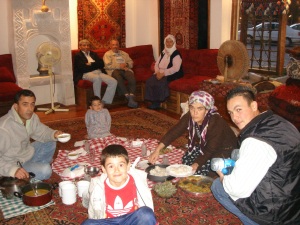
Tahini Pekmez Chicken
4 chicken breasts cut into medium strips
4 tbsp Tahini sesame paste
2 tbsp Pekmez
1/3 cup lemon juice
4-6 cloves garlic-crushed
Salt and freshly ground black pepper.
Topping:1/2 cup wholemeal breadcrumbs or stale bread torn into fine pieces
1/3 cup roughly chopped walnuts
1/3 cup finely chopped fresh parsley or dill or a combination of both.
In a bowl, beat the tahini, pekmez, lemon juice and garlic until smooth and creamy. Add a little water if the consistency is too thick- it should bet he consistency of runny honey. Season with salt and pepper and add the chicken leaving to marinade for at least 1 hr.
Spoon the mixture into a shallow clay dish or oven proof casserole dish. Scatter the breadcrumb and nut herb mixture over the top and place in the oven for 30 mins at 200C.
Serve hot with a light herb and lettuce salad, scattered with pomegranate seeds and enjoy with your daughter and friends!
A celebration of 40 yrs of Textile Collecting
http://www.surfacedesign.org/newsblog/time-material-gail-martin-gallery-at-40
Time & Material: Gail Martin Gallery at 40
by Lois Martin
In 2012, Gail Martin celebrated her 40th anniversary as a textile collector with a successful NYC gallery. For textile arts cognoscenti everywhere, these 4 decades also mark her ongoing influence in the art world, where she has helped transform textiles from “rags” to “riches” in the public imagination.
Martin and Ullman Artweave Textile Gallery opened in 1972 with partners Ocsi Ullman and Vladimir Haustov. The gallery was renamed – and has endured – as Gail Martin Gallery since 1994 when Martin became the sole owner.
Gail Martin’s internationally-recognized name is most closely associated with Central Asian textiles. Her expertise in this area began with trips to Afghanistan in the early 1970s, undertaken with then-partner Vladimir Haustov. The two traveled into remote areas where they were awestruck by the brilliant beauty of local textiles – especially dramatic ikat-dyed silks and floral embroideries. At that time, these textiles were virtually unknown and undocumented in the West. Martin was struck not only by their virtuosity but also by their aesthetic compatibility with contemporary art.
As the niece of American artist Ben Shahn, Martin had grown up surrounded by art. She recognized the visual sophistication of these fabrics. While the shimmering colors and bold designs of the ikats resonated with Abstract Expressionism and Color Field work (especially, for example, the late paintings of Mark Rothko or the color studies of Josef Albers), the playful, unexpected colors and shapes of the embroidery motifs recalled watercolors by Paul Klee or paper cut-outs by Paul Matisse.
As they traveled in Afghanistan, Martin and Haustov began to purchase textiles, especially old and rare 19th-century pieces. Upon their return to the US, they delved into research on the history, geography and techniques employed in these pieces, thereby honing their expertise. As a way of financing subsequent trips, they began to sell textiles from their home. This enterprise was an instant success. It earned funds for further travel, more research and also brought them into contact with a wide circle of textile experts and collectors.
One of these contacts was Ocsi Ullman, a Turkish-born art dealer whose specialties were Ottoman textiles and Turkish folk art. Ullman immediately grasped the high quality of Martin and Haustov’s collection. Drawn together by their complementary interests, all 3 decided to go into business and open Martin and Ullman Artweave Textile Gallery in 1972 at 2nd Avenue and 52nd Street. Just 2 years later they moved to a lovely “white box” exhibition space on Madison Avenue near the Whitney Museum – in the heart of Manhattan’s fine art district – where they became known for their outstanding exhibitions.
The gallery’s opening coincided with a heady period for textiles in the art world. The collective energy of 1970’s peace, protest, and “back to the land” movements had sparked general interest in things handmade and in folk traditions. Major museum exhibitions began headlining cloth with titles like: African Textiles and Decorative Arts (1972); The Navajo Blanket (1972), and Abstract Design in American Quilts (1971) which helped viewers see the link between modern art and old cloth. This consciousness-raising initiated a wave that swept textiles into the art world from their former lowly position as “folk art” or “handicraft” to a new status as Art with a capital “A”. Art books with outstanding photo-documentation and critical writing appeared to promote textiles, too. The textile designer and collector Jack Lenor Larsen collaborated on some of the most gorgeous books ever published on “art cloth”. One of these, The Dyer’s Art: Ikat, Batik, Plangi (1976), featured several rich Uzbek silk ikats from Artweave Textile Gallery in a 2-page spread.
Martin’s reputation is based on her ability to select pieces for their visual impact as well as technical virtuosity. In a New York Times review of the 1987 show Masterpieces of Ancient Peru: Textiles and Featherwork, art critic Rita Reif compared the pulsating effects of stripes, twin images, and simultaneous color contrast in the Nazca and Huari weavings (700—1000 A.D.) to Frank Stella painting of the 1960′s. She subtitled her review Ancient Patterns, Modern Art.
In a 1998 interview, renowned collector Dr. Guido Goldman describes how, though late for an appointment, he spotted an ikat in the gallery’s 2nd-story window and rushed upstairs to see it (this ikat is shown at top of story). After Martin explained its provenance and described the intricacies of ikat (which involve resist-dying the threads of a cloth prior to weaving), he bought the piece. This was the seed from which the Guido Goldman Collection grew, with Martin serving as curator throughout. Eventually Ikat: Splendid Silks from Central Asia – a blockbuster show – stunned audiences as it traveled to major venues across the country for over 3 years, including, among others: the Museum of Fine Arts in Boston; Freer Gallery at the Smithsonian in Washington, DC; Jewish Museum in New York City; and Art Institute of Chicago. Several major publications accompanied the show; these catalogs are now out of print and are collector’s items in their own right. Martin has also curated a collection of Central Asian nomadic embroidered wall hangings that was accompanied by a catalog, written by Kate Fitz Gibbon and Andrew Hale, entitled Uzbek Embroidery in the Nomadic Tradition (2007).
Over the years, the gallery has expanded its focus as it changed its address. It currently deals in Central Asian textiles as well as in textile works of art from other parts of the world, including ethnographic textiles and hats from Africa, antique textiles from various non-western cultures, and, especially, pre-Columbian textiles from Peru. Martin has also shown the work of a number of contemporary artists whose innovative and conceptual use of textile media is built upon enduring textile techniques. At present, the gallery represents 4 outstanding contemporary fiber artists: Polly Barton, Jim Bassler, Michael Rohde, and Ethel Stein. If we, in the US, followed the Japanese practice of designating master artisans as “living national treasures,” these 4 would definitely fit that category.
Martin no longer mounts public exhibitions at her Riverside Drive venue – but there are always striking textiles on display which can be viewed by appointment. Her gallery contains an extensive art reference library as Martin only offers a piece for sale after careful research. Although tastes may be personal and subjective, Martin is committed to educating her clients about the history, technique and aesthetics of an object. She also advises clients on the conservation, restoration, cleaning, exhibition and storage of fine textiles and provides a variety of conservation, display, appraisal and cataloging services. But her primary – and ongoing – commitment is to educate the eye and help viewers see the visual qualities that distinguish a piece and make it collectible.
Martin is also devoted to sharing textile knowledge. She regularly attends museum programs, symposia and seminars sponsored by textile groups such as Friends of Fiber International, Textile Study Group of New York (TSGNY) and Textile Society of America (TSA). She occasionally sponsors lectures at her gallery. In spring 2012, Jim Bassler spoke about his work and the DC Textile Museum’s Sourcing the Museum exhibition; some years back, Peter Collingwood spoke about his research on textile structures.
The gallery office is a small, jewel-box exhibition space. Within its walls Martin tends to juxtapose ancient and modern works. Side by side, the interaction is magical. On the afternoon I visited, an early Wari tie-dye masterpiece (Peru, 600—1000 AD) hung on the wall around the corner from a wonderful Jim Bassler composition (Thank You Wari 2012), inspired by and executed in the same technique. Another wall showcased a marvelous collection of hats.
In another part of the gallery, Martin had clustered together an improbable set of objects that seemed to be engaged in a formal conversation on a watery theme: the grouping included a Polly Barton weaving with wave-like shapes and silvery metallic threads (Clapping Waters 2011), a Jim Bassler wedge weave with the compositional format of a boat wake on the surface of a lake, and a West African hat studded with hundreds of tiny hand-rolled mud beads stitched to a cap (from the Kirdi people of northwestern Cameroon and northeastern Nigeria). In their multiplicity, these beads suggested the idea of infinite bits, like drops of water or grains of sand.
The side-by-side display of these disparate objects brought out their commonality as works of art. All were creations hard to put a name on but fascinating to gaze at and muse over. All communicated through color, form, tactility and thread (not word or image) — and all bore the shadow-trace of the artist’s hand, working out an idea in material and time.
When I visited the gallery to prepare this piece, I was awed to sit among Martin’s rare and beautiful pieces, while a conservator patiently bent over a great tapestry spread out on a table nearby.
It struck me that as a repository of ancient and wonderful textiles, the gallery might be compared to the “Shosoin” – the 7th-century “Emperor’s treasure house” in Nara, Japan. Built as a vault for imperial wealth, its most prized contents were ancient fabrics.
Gail Martin’s gallery is a treasure house for textiles in its own right: part repository and part clinic, where rare and beautiful pieces are protected and conserved and re-united with their histories. From this small gallery, the textiles travel into new collections, and often the grand halls of museums. They move outward, just as the ripples of Martin’s re-valuation of textiles have made reverberations throughout the art world these last 40 years.
________________________________________
Lois Martin (who is unrelated to Gail Martin) is an artist and writer living in Brooklyn, NY. She frequently writes about art; her interests range from contemporary animation to archaeological textiles.
This is her first article for SDA NewsBlog
Link
Drawings of Cappadocia by Trici Venola
KAPADOKYA / CAPPADOCIA: Drawing Over the Rainbow
http://tricivenola.wordpress.com/category/kapadokya-cappadocia/
Trici is a fabulously talented artist who has her own inspired blog of her drawings of Istanbul but she has wonderfully captured these images of Cappadocia !
Posted on March 28, 2013 by tricivenola
About me
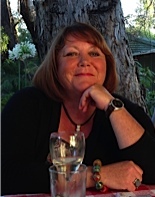 Hi, I’m Ruth.
Hi, I’m Ruth.
I’m a self-confessed Turkophile, passionate textile and oriental carpet expert, foodie, and a bit of a culture diva who’s survived and thrived as a foreign woman in a cave-dwelling Anatolian village for nearly three decades. This blog is to share my passion for Turkey in a sort of ‘Day in the life of…’ style, inspired by the hundreds of people I meet every year that ask me, ‘What is your life like in Turkey?’ ‘How does it feel to be a foreigner/woman/ female carpet dealer/businesswoman/divorced solo mum etc in the inherently man’s world of Turkey?’ and the most loaded question of all, ‘What interests you so much about Turkey that you have stayed for so long?’
Translators needed
A friend of mine posted this today
Translators needed Turkish to English as well as other languages such as Italian Spanish Japanese Korean German, all native speakers welcomed. All we need is translation sector experience.
For this purpose may I please ask you to send this mail to people who might be interested to work with us as well as reply to us if you are interested. The email for this purpose is:
dclarke@languageconnect.net
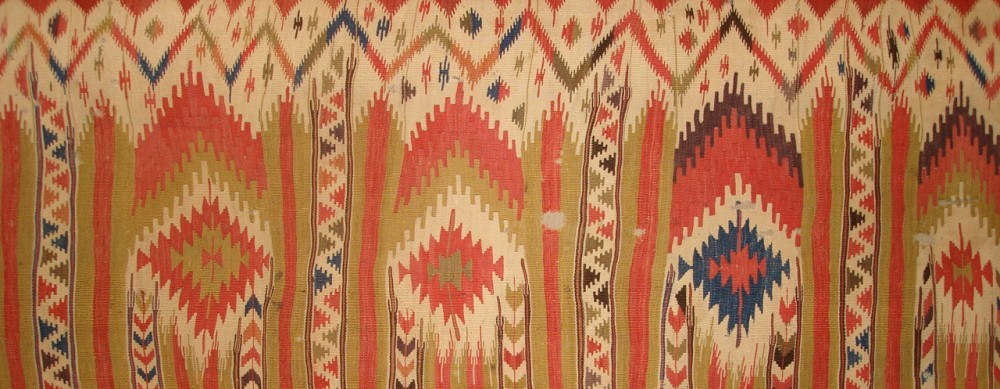

![Orientalism[1]](https://thekilimdiaries.files.wordpress.com/2013/04/orientalism1.jpg?w=236&h=300)
